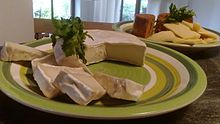**History and Market Trends:**
– Non-dairy cheese originated in China in the 16th century.
– Homemade vegan cheeses were made from soy flour, margarine, and yeast extract.
– Commercial availability started around the 1970s or 1980s.
– The number and types of vegan cheeses have diversified since the early 1990s.
– Global vegan cheese market expected to reach $3.9 billion by 2024.
– Europe holds the largest market share at 43%.
– US plant-based food market projected to reach $4 billion by 2024.
– Annual sales growth for vegan cheeses expected at 8%.
– Common types of vegan cheese include mozzarella, Parmesan, and cheddar.
**Regulation and Labeling Issues:**
– Dairy industry groups push to prohibit terms like cheese on non-dairy products.
– European Union prohibits labeling plant-based products as cheese.
– Canadian Food Inspection Agency ordered a vegan cheese shop to stop using the term cheese.
– Court of Justice of the European Union ruled against labeling plant-based products as cheese.
– Strict standards in the UK prevent non-dairy products from using terms like milk or cheese.
– Turkey banned production and sale of vegan cheese in 2022.
**Ingredients and Production Methods:**
– Common proteins in vegan cheese are derived from soybeans and almonds.
– Gums, proteins, solids, and fats are blended to mimic dairy cheese texture.
– Some vegan cheeses use casein produced by yeast for melting properties.
– Different methods used to create texture and taste in vegan cheeses.
– Fermentation process often used to replicate dairy cheese texture and flavor.
**Nutritional Aspects and Ingredients Used:**
– Vegan cheese is generally low in calcium and protein compared to dairy cheese.
– Most vegan cheese contains no cholesterol and less saturated fat than dairy cheese.
– Some vegan cheeses may be fortified with vitamin B12.
– A study found vegan cheese had higher riboflavin and vitamin B12 than cheddar cheese.
– Vegan cheese may lack vitamin A and D compared to dairy cheese.
– Common ingredients used in vegan cheese: soy protein, solidified vegetable oil, nutritional yeast, agar flakes, nuts (cashews, macadamias, almonds).
**Challenges, Health Concerns, and Future Prospects:**
– Challenges in vegan cheese production include casein-free formulation, use of gums as emulsifiers, achieving realistic melt properties, and substituting traditional cheese ingredients effectively.
– Health and safety concerns related to outbreaks linked to fermented cashew nut cheese and the importance of proper food handling in vegan cheese production.
– Evolution and future prospects include improved versions of vegan cheese, innovation in plant-based dairy substitutes, technological advancements in vegan cheese production, growing interest in vegan alternatives to traditional dairy, and the potential for vegan cheese to compete with dairy products.
Vegan cheese is a category of non-dairy, plant-based cheese analogues. Vegan cheeses range from soft fresh cheeses to aged and cultured hard grateable cheeses like plant-based Parmesan. The defining characteristic of vegan cheese is the exclusion of all animal products.
 | |
| Main ingredients | Cashew, almond, sesame, sunflower, pine nut, peanuts, soybeans, coconut oil, nutritional yeast, tapioca, rice or potatoes |
|---|---|

Vegan cheese can be made with components derived from vegetables, such as proteins, fats and milks (plant milks). It also can be made from seeds, such as sesame, sunflower, nuts (cashew, pine nut, peanuts, almond) and soybeans; other ingredients are coconut oil, nutritional yeast, tapioca, rice, potatoes and spices.
